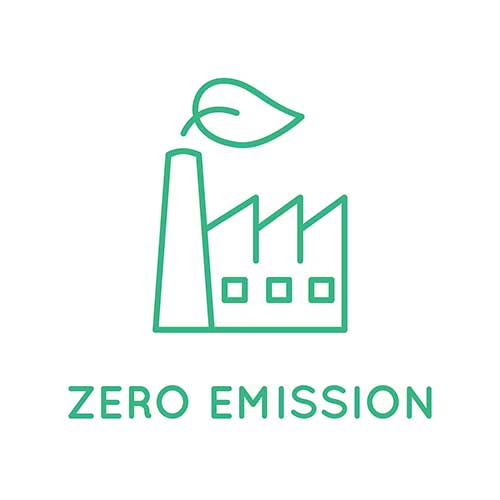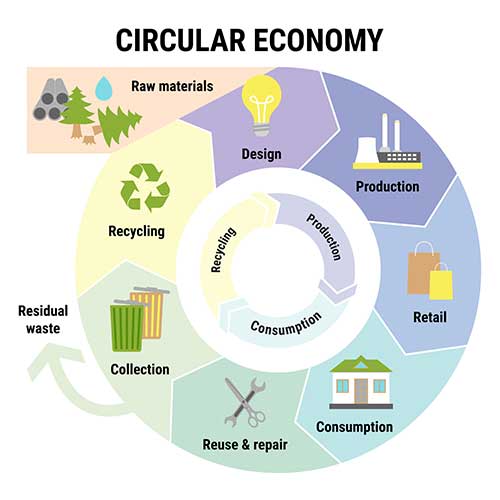Greenhouse gases are on the rise and net zero is becoming an expectation for companies. What does it mean for manufacturers?
By Mark Reisig
“There is unequivocal evidence that Earth is warming at an unprecedented rate. Human activity is the principal cause.” (NASA Climate Evidence 2023) Greenhouse gases (GHG) continue to rise, trapping the sun’s energy and warming our planet. Currently, we are experiencing global warming at 1.11°C warmer than pre-industrial levels. Based on countries’ national climate plans, we are on pace to reach 2.8°C by the end of the century. (UN Emissions Gap Report 2022) This is far above the 2.0°C limit called for in the 2015 Paris Agreement. To reach the goal of limiting global warming to no more than 1.5°C—as called for in the agreement—emissions need to be reduced by 45% by 2030, just 7 years away. For 2°C, we’d still need to cut 30% by 2030. (United Nations Climate Plan 2023)

Reducing greenhouse gas (GHG) emissions and transforming to a decarbonized economy is the defining issue of our time. Today, over 90% of S&P 500 companies report on their environmental, social, and government (ESG) status, as do about 70% of the Russel 1,000 companies. (McKinsey and Company 2022) Consumers and investors are pressuring companies to rethink how they manage their product lifecycles. As the climate worsens, and all indications are it will, the requirement on companies to reduce their GHG emissions to “net-zero” emissions will only heighten.
This green energy transition, requires companies to shift away from fossil fuels to renewable sources such as wind, solar, hydroelectric, geothermal, and biomass. There are additional “clean” energy sources such as green hydrogen, lithium-ion batteries, and nuclear, as well as innovations like a distributed smart grid, improved long duration energy storage, and others that will also play a part in transitioning away from fossil fuels.
This not only impacts the energy industry in terms of how we generate electricity and heat for residential and commercial use, but the many other industries that contribute to the increase in GHGs, including many types of industrial manufacturing, construction, transportation, shipping, aviation, agricultural, land use change, and others.
Traditionally, companies designed products with heavy emphasis on low-cost manufacturability and profit with little concern for the actual cost or impact to our environment. Consider cell phones—of the estimated 16 billion possessed worldwide, over 5 billion were discarded or taken out of service in 2022. (United Nations Institute for Training and Research 2022) Despite containing gold, copper, silver, palladium, and other recoverable components, most are incinerated, causing significant harm to people and the planet.
In recent years, the focus has been on smart, connected products and the need to transform how these products are changing the ways organizations work. Now companies must fundamentally shift from a profit-only motive to one that also mitigates the impact their products and operations have on people and the planet. Faced with this green transition and the need to design for circularity and sustainable operations, companies are rethinking their product lifecycle management (PLM) strategies.
This means embracing sustainable design with the end-of-life in mind. It is estimated that more than 80% of the environmental impact of a new product is locked-in during the design phase, so companies must practice sustainable eco-design in every phase of the product lifecycle. (European Union Science Hub Sustainability Policy) The design phase includes designing for durability, reusability, upgradability, repairability, disassembly and re-assembly, material selection and green chemistry, dematerialization (also known as light weighting), modularity, and recyclability.

A related challenge is that most new product introductions are largely incremental innovations. Regardless, companies need to reconsider how they embed sustainability into their culture, processes, and every aspect of their product lifecycle. Much of their legacy processes that worked in a linear economy, where materials were mined, processed, sold, and ultimately discarded, won’t work in a circular economy where the consumption of the product and all these raw materials reside and must be accounted for in a continuous closed loop.
Despite this challenge and short-term economic and geo-political challenges, this requirement will only intensify as consumers and investors demand change, change policymakers are beginning to mandate. Using the cell phone example, a Dutch electronics manufacturer, Fairphone, introduced a more modular smartphone that doesn’t compare feature-wise with the latest Apple and other smartphones with a notable exception. It is more sustainable—more durable, repairable, upgradable, and with a lower carbon footprint than their industry competitors. In response to intense pressure, Apple has committed to be carbon neutral by 2030, including its entire multi-tiered supply chain. They are embracing sustainability throughout the lifecycle, including design, manufacturing, durability, repair, and recycling. (United Nations Institute for Training and Research 2022)
In 2016, 13 companies had committed to science-based net-zero targets. Today, over 4,500 have committed publicly to science-based “net zero” targets. (Sciencebasedtargets.org 2023) It is one thing to say you’ll be net-zero by a given date—it is much harder to achieve it.
To meet their ambitious goals, many companies use Life Cycle Assessments (LCAs) to set targets for their operations and products. To reduce their product carbon footprint (PCF), they must accurately account for their GHG emissions within a boundary. To do this, they use basic carbon accounting where they convert the different types of GHG into a common carbon dioxide equivalent (CO2e) Then for every part of the product lifecycle from raw material extraction, through materials processing, manufacture, distribution, use, and end-of-life, they break these emissions down into three “scopes.” Any direct GHG emission from the parent company is referred to as scope 1.
Scope 2 is the electricity and heat consumed by the company. This has caused many companies to use renewable sources. Many companies are negotiating contracts with power and utility providers to make sure they get renewable energy. Others have invested in private microgrids and are making use of renewable energy sources directly. In addition to lowering their carbon footprint, this can be less expensive, more predictable, and reduces the chance of going offline.
Scope 3 consists of all other indirect emissions that occur within the value chain, including both upstream and downstream emissions. This is by far the most complex to account for and includes 15 sub-categories. For most companies, 65% to 95% of their GHG carbon footprint resides in their supply chain. (CNBC Climate experts are worried about the toughest carbon emissions for companies to capture 2021)
This is causing many companies to change their product lifecycle management (PLM) strategy because most of the GHG is found in the part or material itself, known as embodied carbon. Remember that over 80% of the environmental impact of a product is determined during the design phase, and since most of the parts and materials come from the supply chain, product design needs visibility to the CO2e of the material or parts sourced from the supply chain. Along with that product design, sourcing, manufacturing, and service organizations need this type of transparency as well.
Organizations that want to do this right need to also consider the “should cost,” possible suppliers, any risks associated with the suppliers, and all CO2e related to where the material will be manufactured, and the impact and cost of transportation, also known as supplier miles. They should also consider having an internal cost for the carbon, since it really does have a cost.
Instead of viewing this as a necessary auditing task, companies are beginning to look at this as an opportunity to embed sustainability into their PLM processes and reduce their PCF throughout the product’s lifecycle. In addition to a lower PCF, these insights should yield lower costs, improved product quality, use less waste, improve their time-to-market, build a more resilient supply chain, and become more competitive.
The alternative of making “net-zero” commitments that are essentially unsubstantiated and attempting to audit what had occurred in the past is costly and could be misleading to shareholders, potential investors, and consumers.
Companies must also consider transforming their business model to reflect the consumer demand for a more circular experience, where the outcomes the products provide—the service—is monetized instead of “selling” the product as they did in the past. This is known as product-as-a-service (PaaS) and puts the onus on the manufacturer to provide a more sustainable and cost-effective experience.
This has emerged as a powerful concept with the use of digital twins—virtual replicas of assets in the field. When combined with sensors and the Internet of Things (IoT), they enable decreased maintenance costs, predictive maintenance, real-time remote monitoring, and better insights to improve or upgrade the products (services). When companies combine this with a product innovation platform and a digital thread, they improve their collaboration across the product lifecycle, reduce their operational costs, and create a more sustainable experience for both themselves and their customers. Additionally, companies are beginning to use Artificial Intelligence (AI) to identify patterns, learn, and improve the performance of their green assets.
PLM is the strategic business approach that puts a company’s products and services and the processes by which they are defined, produced, and serviced at the heart of a company, directly linked to their business strategy. It supports the collaborative creation, management, dissemination, and use of product definition information supporting the extended enterprise (i.e., customers, design, supply partners, etc.) spanning from concept through end of life of a product or plant. PLM integrates people, processes, business systems, and information, and empowers the business, enables product and process innovation, and enhances both top- and bottom-line business performance.
A well-implemented PLM strategy that embeds sustainability throughout the product lifecycle is critical as organizations transform to reduce the environmental impact of their products and services.

Mark Reisig is an Executive Consultant and Practice Manager at CIMdata where he focuses on Green Energy enablement. Mark has had an extensive career in PLM with GE, Federation, Oracle, Auto-trol Technology, Kraft-Heinz, Catalytic, Day & Zimmermann, and most recently, Aras, where he was the Vice President of Product Marketing.
In this episode, I sat down with Beejan Giga, Director | Partner and Caleb Emerson, Senior Results Manager at Carpedia International. We discussed the insights behind their recent Industry Today article, “Thinking Three Moves Ahead” and together we explored how manufacturers can plan more strategically, align with their suppliers, and build the operational discipline needed to support intentional, sustainable growth. It was a conversation packed with practical perspectives on navigating a fast-changing industry landscape.